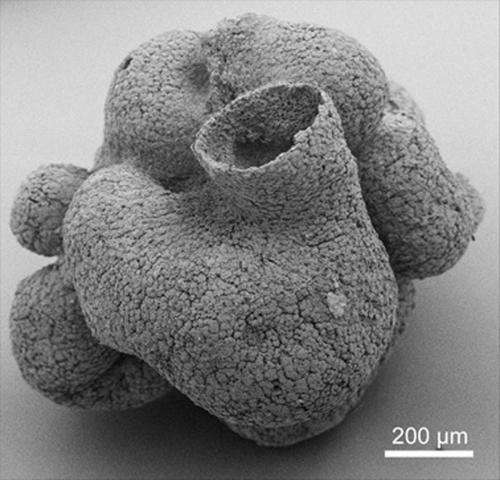March 10, 2015 report
Oldest known sponge found in China

(Phys.org)—A team of researchers with members from China, the U.S. and France has identified an ancient sponge found in a geologic formation in southern China and have dated it to 600 million years ago. In their paper published in Proceedings of the National Academy of Sciences, the team claims the sponge is the oldest ever found and likely represents a group of descendants that is an ancestor of all sponges.
Sponges have been the object of research for quite some time, but when they first appeared on Earth has been the subject of debate, with estimates ranging from 700 million years ago to a time known as the Cambrian period (541 million to 485 million years ago). This new finding would place the sponge approximately 60 million years before the Cambrian started. Researchers want to pin down the date because they believe it is critical to understanding early animal evolution—the split between sponges and most other animals, it is believed, was a major event in the early history of life on our planet.
In any case, the find is impressive because of its condition, it is nearly pristine—and tiny, just over one millimeter in height and width. To get a good look at it required scanning electron microscopy and X-ray technology. The team has named it Eocyathispongia qiania and note that it is made up of hundreds of thousands of cells and is formed in three tube-like chambers that are affixed to a common base, with cell structures that resemble those in modern sponges. They also found surface cells that indicate pores, again, like modern sponges, which control water flowing into the organism. There was also an area inside one of the tubes with pits surrounded by raised collars, a possible precursor to choanocyte cells which modern sponges use to move water through their bodies.
In addition to being the oldest of the really old sponge fossils found, the find also represents one of the most pristine. It cannot be confirmed as yet, of course, because that requires more than one specimen example. The researchers appear optimistic that such confirmation will be forthcoming, however, as they have more material from the site where the sponge was found, and will be sifting through it looking for more tiny sponges and perhaps other organisms as well.
More information: Sponge grade body fossil with cellular resolution dating 60 Myr before the Cambrian, PNAS, Zongjun Yin, DOI: 10.1073/pnas.1414577112
Abstract
An extraordinarily well preserved, 600-million-year (Myr)-old, three-dimensionally phosphatized fossil displaying multiple independent characters of modern adult sponges has been analyzed by SEM and synchrotron X-ray tomography. The fossilized animal (Eocyathispongia qiania gen. et sp. nov.) is slightly more than 1.2 mm wide and 1.1 mm tall, is composed of hundreds of thousands of cells, and has a gross structure consisting of three adjacent hollow tubes sharing a common base. The main tube is crowned with a large open funnel, and the others end in osculum-like openings to the exterior. The external surface is densely covered with flat tile-like cells closely resembling sponge pinacocytes, and this layer is punctuated with smaller pores. A dense patch of external structures that display the form of a lawn of sponge papillae has also survived. Within the main funnel, an area where features of the inner surface are preserved displays a regular pattern of uniform pits. Many of them are surrounded individually by distinct collars, mounted in a supporting reticulum. The possibility cannot be excluded that these pits are the remains of a field of choanocytes. The character set evinced by this specimen, ranging from general anatomy to cell type, uniquely indicates that this specimen is a fossil of probable poriferan affinity. So far, we have only this single specimen, and although its organized and complex cellular structure precludes any reasonable interpretation that its origin is abiogenic, confirmation that it is indeed a fossilized sponge will clearly require discovery of additional specimens.
Journal information: Proceedings of the National Academy of Sciences
© 2015 Phys.org


















